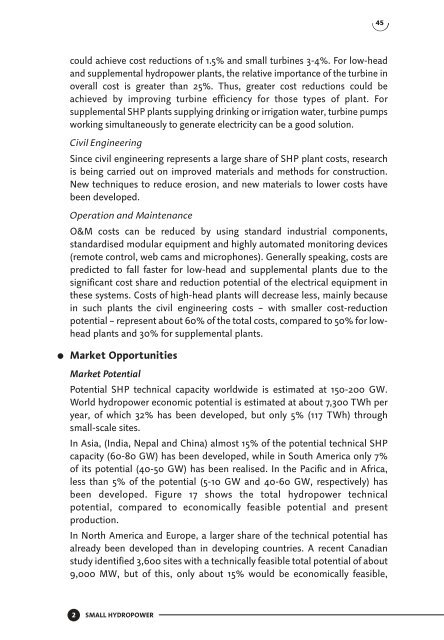Technology Status - NET Nowak Energie & Technologie AG
Technology Status - NET Nowak Energie & Technologie AG
Technology Status - NET Nowak Energie & Technologie AG
You also want an ePaper? Increase the reach of your titles
YUMPU automatically turns print PDFs into web optimized ePapers that Google loves.
could achieve cost reductions of 1.5% and small turbines 3-4%. For low-head<br />
and supplemental hydropower plants, the relative importance of the turbine in<br />
overall cost is greater than 25%. Thus, greater cost reductions could be<br />
achieved by improving turbine efficiency for those types of plant. For<br />
supplemental SHP plants supplying drinking or irrigation water, turbine pumps<br />
working simultaneously to generate electricity can be a good solution.<br />
Civil Engineering<br />
Since civil engineering represents a large share of SHP plant costs, research<br />
is being carried out on improved materials and methods for construction.<br />
New techniques to reduce erosion, and new materials to lower costs have<br />
been developed.<br />
Operation and Maintenance<br />
O&M costs can be reduced by using standard industrial components,<br />
standardised modular equipment and highly automated monitoring devices<br />
(remote control, web cams and microphones). Generally speaking, costs are<br />
predicted to fall faster for low-head and supplemental plants due to the<br />
significant cost share and reduction potential of the electrical equipment in<br />
these systems. Costs of high-head plants will decrease less, mainly because<br />
in such plants the civil engineering costs – with smaller cost-reduction<br />
potential – represent about 60% of the total costs, compared to 50% for lowhead<br />
plants and 30% for supplemental plants.<br />
● Market Opportunities<br />
Market Potential<br />
Potential SHP technical capacity worldwide is estimated at 150-200 GW.<br />
World hydropower economic potential is estimated at about 7,300 TWh per<br />
year, of which 32% has been developed, but only 5% (117 TWh) through<br />
small-scale sites.<br />
In Asia, (India, Nepal and China) almost 15% of the potential technical SHP<br />
capacity (60-80 GW) has been developed, while in South America only 7%<br />
of its potential (40-50 GW) has been realised. In the Pacific and in Africa,<br />
less than 5% of the potential (5-10 GW and 40-60 GW, respectively) has<br />
been developed. Figure 17 shows the total hydropower technical<br />
potential, compared to economically feasible potential and present<br />
production.<br />
In North America and Europe, a larger share of the technical potential has<br />
already been developed than in developing countries. A recent Canadian<br />
study identified 3,600 sites with a technically feasible total potential of about<br />
9,000 MW, but of this, only about 15% would be economically feasible,<br />
2<br />
SMALL HYDROPOWER<br />
45







